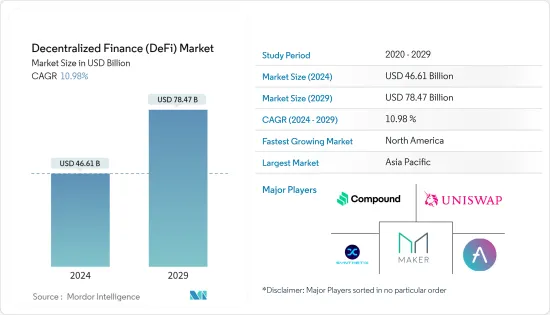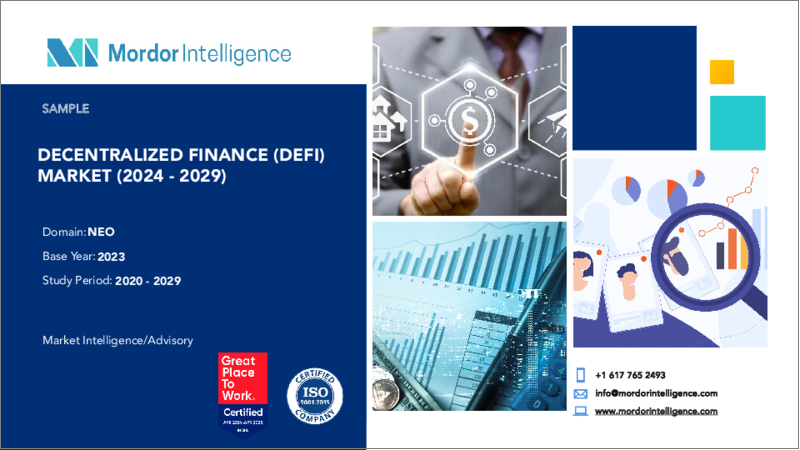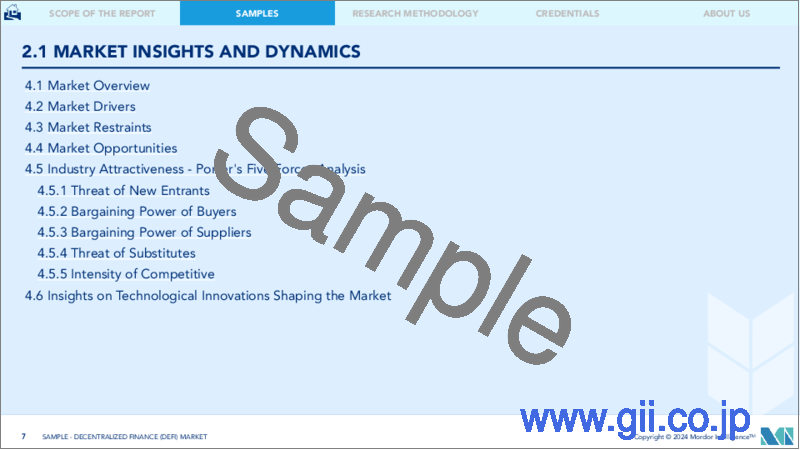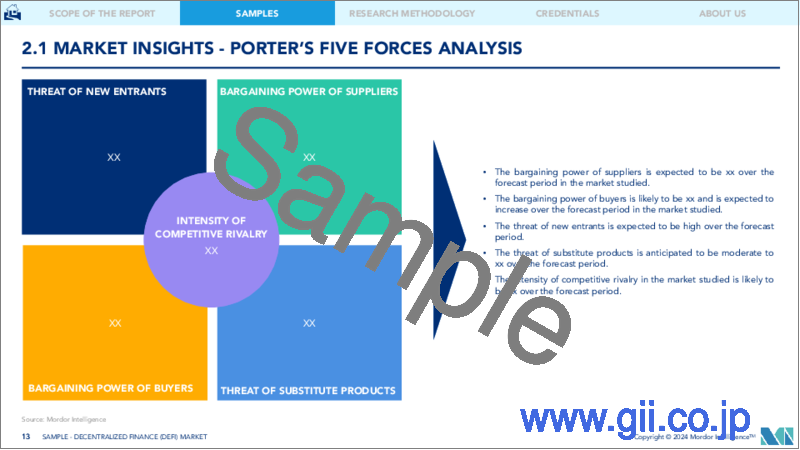|
|
市場調査レポート
商品コード
1537724
分散型金融(DeFi):市場シェア分析、業界動向・統計、成長予測(2024年~2029年)Decentralized Finance (DeFi) - Market Share Analysis, Industry Trends & Statistics, Growth Forecasts (2024 - 2029) |
||||||
カスタマイズ可能
適宜更新あり
|
|||||||
| 分散型金融(DeFi):市場シェア分析、業界動向・統計、成長予測(2024年~2029年) |
|
出版日: 2024年08月14日
発行: Mordor Intelligence
ページ情報: 英文 120 Pages
納期: 2~3営業日
|
全表示
- 概要
- 目次
分散型金融(DeFi)市場規模は2024年に466億1,000万米ドルと推定・予測され、2029年には784億7,000万米ドルに達し、予測期間中(2024-2029年)のCAGRは10.98%で成長すると予測されます。

DeFi市場は、その発足以来、大きな成長と革新を遂げてきました。TVL(Total Value Locked)は、分散型金融の全体的な規模と活動を評価するために一般的に使用される指標です。これは、DeFiプロトコル内にロックされた資産の総額です。分散型金融(DeFi)という用語は、ブロックチェーンのような分散型技術を使用して確立された金融サービスやプロセスを複製する、暗号通貨市場の急速に拡大しているサブセットです。分散型金融アプリケーションは通常、イーサリアムのようなパブリックブロックチェーン上で動作し、スマートコントラクトを利用して金融取引を自動化し、仲介者を不要にします。分散型金融は、貸し借りプラットフォーム、分散型取引所(DEX)、ステーブルコイン、イールドファーミング、保険など、さまざまな金融サービスを提供しています。消費者が従来の金融機関から独立してこれらのサービスを利用することを可能にし、より大きな金融包摂性、透明性、資産管理を促進します。
分散型金融(DeFi)市場の動向
ブロックチェーン・ソリューションの台頭が市場を後押し
ブロックチェーン技術は、金融取引に信頼性と透明性の高い環境を提供します。DeFiアプリケーションは、スマートコントラクトを活用することで、仲介者を介さずに取引のルールを自動化し、実施することができます。ブロックチェーン技術は、異なるDeFiプロトコルとアプリケーション間の相互運用性を可能にします。異なるDeFiプラットフォームがシームレスに相互作用し、統合することができます。この相互運用性により、DeFiプロトコルの複合化が可能になり、開発者は異なるビルディングブロックを組み合わせて、新しく革新的な金融商品を生み出すことができます。DeFiはパブリック・ブロックチェーン上で運営されており、インターネット接続があれば誰でもアクセスできます。この世界なアクセシビリティにより、個人は従来の銀行口座や信用履歴を必要とせずに金融活動に参加することができます。
アジアで増加する分散型金融
アジアは、特にブロックチェーンと暗号通貨の分野において、技術的進歩の最前線にいます。香港、シンガポール、韓国はブロックチェーンのイノベーションと開発のハブとしての地位を確立しています。技術に精通した人々の存在と、支援的な規制環境が、これらの地域におけるDeFiの成長を促進しています。多くのアジア諸国は、銀行口座を持たない、あるいは銀行口座を持たない人口が多く、伝統的な金融サービスにアクセスできない、あるいは制限されています。DeFiは、銀行にアクセスできない人々への融資、借入、投資によってこの問題を解決します。この金融包摂の可能性が、アジアにおけるDeFiの採用を後押ししています。DeFiのプロトコルは、高速、低コスト、安全な国境を越えた取引を可能にし、従来の送金サービスに代わるサービスを提供しています。フィリピンやベトナムのように、海外労働者が送金に大きく依存している国では、このサービスが支持されています。
分散型金融(DeFi)業界の概要
分散型金融市場は新しい市場であるため、企業は少数で集約されています。市場の主要企業には、MakerDAO、Compound、Aave、Uniswap、Synthetixなどがあります。調査期間中、市場企業は市場でのプレゼンス拡大に焦点を当てたM&Aやパートナーシップにも関与しました。同市場は予測期間中に成長する機会を提供しており、市場競争をさらに促進すると予想されます。しかし、技術の進歩や製品の革新に伴い、中堅から中小企業は新規契約の獲得や新規市場の開拓によって市場での存在感を高めています。
その他の特典:
- エクセル形式の市場予測(ME)シート
- 3ヶ月間のアナリスト・サポート
目次
第1章 イントロダクション
- 調査の前提条件と市場定義
- 調査範囲
第2章 調査手法
第3章 エグゼクティブサマリー
第4章 市場力学
- 市場概要
- 市場促進要因
- 代替金融ソリューションへの関心の高まり
- 市場抑制要因
- 潜在的なセキュリティ脆弱性とスマートコントラクトのリスク
- 市場機会
- 分散型貸し借りプラットフォームの可能性
- ポーターズ5フォース分析
- 新規参入業者の脅威
- 買い手・消費者の交渉力
- 供給企業の交渉力
- 代替品の脅威
- 競争企業間の敵対関係の強さ
- 市場における技術革新に関する洞察
- COVID-19が市場に与える影響
第5章 市場セグメンテーション
- コンポーネント別
- ブロックチェーン技術
- スマートコントラクト
- 用途別
- ペイメント
- ステーブルコイン
- 地域別
- 北米
- 米国
- カナダ
- メキシコ
- その他北米地域
- 欧州
- ドイツ
- 英国
- フランス
- ロシア
- スペイン
- その他欧州
- アジア太平洋
- インド
- 中国
- 日本
- その他アジア太平洋地域
- 南米
- ブラジル
- アルゼンチン
- その他南米
- 中東
- UAE
- サウジアラビア
- その他中東
- 北米
第6章 競合情勢
- Market Concentration
- 企業プロファイル
- MakerDAO
- Compound
- Aave
- Uniswap
- Synthetix
- SushiSwap
- Yearn.finance
- Curve Finance
- Balancer
- Chainlink
第7章 市場動向
第8章 免責事項と出版社について
The Decentralized Finance Market size is estimated at USD 46.61 billion in 2024, and is expected to reach USD 78.47 billion by 2029, growing at a CAGR of 10.98% during the forecast period (2024-2029).

The DeFi market has experienced significant growth and innovation since its inception. Total value locked (TVL) is a commonly used metric to assess the overall size and activity of the DeFi market. It represents the total value of assets locked within DeFi protocols. The term "decentralized finance" (DeFi) is a quickly expanding subset of the cryptocurrency market that uses decentralized technology like blockchain to replicate established financial services and processes. DeFi applications typically operate on public blockchains like Ethereum and utilize smart contracts to automate financial transactions and eliminate the need for intermediaries. DeFi offers various financial services, including lending and borrowing platforms, decentralized exchanges (DEXs), stablecoins, yield farming, and insurance. It enables consumers to use these services independently of conventional financial institutions, promoting greater financial inclusivity, transparency, and control over assets.
Decentralized Finance (DeFi) Market Trends
Rise in Blockchain Solutions is Fuelling the Market
Blockchain technology provides a trustless and transparent environment for financial transactions. DeFi applications can automate and enforce the rules of a transaction without the need for intermediaries by utilizing smart contracts. Blockchain technology allows for interoperability between different DeFi protocols and applications. Different DeFi platforms can seamlessly interact and integrate. This interoperability enables the composability of DeFi protocols, where developers can combine different building blocks to create new and innovative financial products. DeFi operates on public blockchains, which are accessible to anyone with an internet connection. This global accessibility enables individuals to participate in financial activities without needing a traditional bank account or credit history.
Increasing Decentralized Finance in Asia
Asia has been at the forefront of technological advancements, particularly in the blockchain and cryptocurrency space. Hong Kong, Singapore, and South Korea have established themselves as blockchain innovation and development hubs. The presence of tech-savvy populations and a supportive regulatory environment have facilitated the growth of DeFi in these regions. Many Asian countries have large unbanked or underbanked populations, where traditional financial services are inaccessible or limited. DeFi solves this problem by lending, borrowing, and investments to people who don't have access to banks. This potential for financial inclusion has driven the adoption of DeFi in Asia. DeFi protocols enable fast, low-cost, and secure cross-border transactions, providing an alternative to traditional remittance services. This has gained traction in countries like the Philippines and Vietnam, where overseas workers rely heavily on remittances.
Decentralized Finance (DeFi) Industry Overview
The Decentralized finance market, being a new market, is consolidated with few players. Some of the major players in the market include MakerDAO, Compound, Aave, Uniswap, and Synthetix, among others. In the study period, market players were also involved in mergers and acquisitions, and partnerships focused on expanding their presence in the market. The market presents opportunities for growth during the forecast period, which is expected to drive the market competition further. However, with technological advancement and product innovation, mid-size to smaller companies are increasing their market presence by securing new contracts and tapping new markets.
Additional Benefits:
- The market estimate (ME) sheet in Excel format
- 3 months of analyst support
TABLE OF CONTENTS
1 INTRODUCTION
- 1.1 Study Assumptions and Market Definition
- 1.2 Scope of the Study
2 RESEARCH METHODOLOGY
3 EXECUTIVE SUMMARY
4 MARKET DYNAMICS
- 4.1 Market Overview
- 4.2 Market Drivers
- 4.2.1 Increasing Interest in Alternative Finance Solutions
- 4.3 Market Restraints
- 4.3.1 The Potential Security Vulnerabilities and Smart Contract Risks
- 4.4 Market Opportunities
- 4.4.1 Potential for Decentralized Lending and Borrowing Platforms
- 4.5 Porters 5 Force Analysis
- 4.5.1 Threat of New Entrants
- 4.5.2 Bargaining Power of Buyers/Consumers
- 4.5.3 Bargaining Power of Suppliers
- 4.5.4 Threat of Substitute Products
- 4.5.5 Intensity of Competitive Rivalry
- 4.6 Insights on Technological Innovations in the Market
- 4.7 Impact of Covid-19 on the Market
5 MARKET SEGMENTATION
- 5.1 By Component
- 5.1.1 Blockchain Technology
- 5.1.2 Smart Contracts
- 5.2 By Application
- 5.2.1 Payments
- 5.2.2 Stablecoins
- 5.3 Geography
- 5.3.1 North America
- 5.3.1.1 US
- 5.3.1.2 Canada
- 5.3.1.3 Mexico
- 5.3.1.4 Rest of North America
- 5.3.2 Europe
- 5.3.2.1 Germany
- 5.3.2.2 UK
- 5.3.2.3 France
- 5.3.2.4 Russia
- 5.3.2.5 Spain
- 5.3.2.6 Rest of Europe
- 5.3.3 Asia Pacific
- 5.3.3.1 India
- 5.3.3.2 China
- 5.3.3.3 Japan
- 5.3.3.4 Rest of Asia Pacific
- 5.3.4 South America
- 5.3.4.1 Brazil
- 5.3.4.2 Argentina
- 5.3.4.3 Rest of South America
- 5.3.5 Middle East
- 5.3.5.1 UAE
- 5.3.5.2 Saudi Arabia
- 5.3.5.3 Rest of Middle East
- 5.3.1 North America
6 COMPETITIVE LANDSCAPE
- 6.1 Market Concentration
- 6.2 Company Profiles
- 6.2.1 MakerDAO
- 6.2.2 Compound
- 6.2.3 Aave
- 6.2.4 Uniswap
- 6.2.5 Synthetix
- 6.2.6 SushiSwap
- 6.2.7 Yearn.finance
- 6.2.8 Curve Finance
- 6.2.9 Balancer
- 6.2.10 Chainlink*






